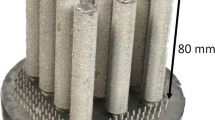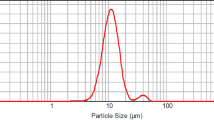Abstract
Borides are considered advanced building materials due to their high melting temperature, hardness, wear/corrosion/oxidation resistance and excellent thermal and electrical properties. Among the many metal borides, chromium borides are known for their high electrical conductivity and high hardness. In this study, it is aimed to form CrxBx on powder metal pure Cr material and to examine its wear characteristics. For the production of samples, commercial purity Cr powders were mixed for 60 min and pressed under 850 MPa pressure to obtain raw samples. After pressing, the samples were boronized at 1000 ºC for 2, 4, 6 and 8 h, and a hard boride layer was formed on the outer surface. Hardness, abrasion tests and then then Field Emission Scanning Electron Microscopy, energy-dispersive x-ray spectroscopy and x-ray diffraction analyzes were applied to the samples obtained. It was determined that CrB, Cr2B, Cr2B3and Cr3B4 borides were formed on the surface with boronizing process and the hardness of these phases increased significantly. The wear resistance of P/M Cr specimens could also be improved by increasing the hardness.








Similar content being viewed by others
References
Y. Kayali and E. Mertgenç, Investigation of Diffusion Kinetic Values of Boronized AISI 303 Steel by Pack Boronizing, Prot. Met. Phys. Chem. Surf., 2020, 56(1), p 151–155.
N. Ucar et al., Boriding of Binary Ni-Ti Shape Memory Alloys, Zeıtschrıft Fur Naturforschung Sect. A-A J Phys. Sci., 2016, 71(11), p 1017–1020.
O. Allaoui, N. Bouaouadja, and G. Saindernan, Characterization of Boronized Layers on a XC38 Steel, Surf. Coat. Technol., 2006, 201, p 3475–3482.
A. Ulukoy, A.C. Can, Y. Ozmen, S. Tasgetiren, and S., Borocarburizing of Decarburized Gears Made From 21NiCrMo2 (AISI 8620) Steel, Proceedings of the Institution of Mechanical Engineers, Part L: Journal of Materials: Design and Applications, 2015, 229(3), p 226–235.
A.K Sinha, Boriding (Boronizing), (ASM Handbook, 1991). pp. 417.
M. Kulka, N. Makuch, and M. Popławski, Two-stage Gas Boriding of Nisil in N2–H2–BCl3 Atmosphere, Surf. Coat. Technol., 2014, 244, p 78.
N. Makuch and M. Kulka, Microstructural Characterization and Some Mechanical Properties of Gas-Borided Inconel 600-alloy, Appl. Surf. Sci., 2014, 314, p 1007.
N. Makuch, M. Kulka, and A. Piasecki, The Effects of Chemical Composition of Nimonic 80A-alloy on the Microstructure and Properties of Gas-Borided Layer, Surf. Coat. Technol., 2015, 276, p 440.
N. Makuch, M. Kulka, and D. Mikołajczak, Corrosion Behavior of Hard Boride Layer Produced on Nimonic 80A-alloy by Gas Boriding, Transactions of the IndianInstitute of Metals, 2017, 70(10), p 2509–2527.
A. Grafvon Matuschka, Borieren im Wirbelbett, Boronizing, Hanser, 1980
P. Dearnleyand and T. Bell, Engineering the Surface with Boron Based Materials, Surf. Eng., 1985, 1(3), p 203–217.
J.H. Yoon, Y.K. Jee, and S.Y. Lee, Plasma Paste Boronizing of AISI 8620, 52100 and 440C Steels, Surf. Coat. Technol., 1999, 112, p 71.
S. Ulker, I. Gunes, and S. Taktak, Investigation of Tribological Behaviour of Plasma Paste, 52100 and 440C steels, Indian J. Eng. Mater. Sci, 2011, 18, p 370.
S. Ulker, I. Gunes, and S. Taktak, Plasma Paste Boronizing of AISI 8620, 52100 and 440C steels, Mater. Des., 2011, 32, p 2380.
M. Keddam et al., Characterization and Diffusion Kinetics of the Plasma Paste Borided AISI 440C steel, Trans. Indian. Inst. Met., 2017, 70, p 1377.
M. Keddam et al., Mechanical Properties and Kinetics of Boride Layers on AISI D2 Steel Produced by Plasma Paste Boriding, Indian J. Eng. Mater. Sci. (IJEMS), 2021, 27(2), p 221–233.
Y. Gencer, Influence of Manganese on Pack Boriding Behaviour of Pure Iron, Surf. Eng., 2011, 27(8), p 634–638.
I. Gunes, S. Ulker, and S. Taktak, Plasma Paste Boronizing of AISI 8620, 52100 and 440C Steels, Mater. Des., 2011, 32(4), p 2380–2386.
C.A. Cuao-Moreu et al., Effect of the Catalyst Concentration, the Immersion Time and the Aging Time on the Morphology, Composition and Corrosion Performance of TEOS-GPTMS Sol-gel Coatings Deposited on the AZ31 Magnesium Alloy, Surf. Coat. Technol., 2015, 284, p 258–263.
M. Usta et al., A Comparative Study of Borided Pure Niobium, Tungsten and Chromium, Vacuum, 2006, 80(11–12), p 1321–1325.
R. Ribeiro, S. Ingole, M. Usta, C. Bindal, A.H. Ucisik, and H. Liang, A Tribological Comparison of Pure and Boronized Chromium, J. Tribol, 2006, 128(4), p 895–898.
C.A. Cuao-Moreu et al., Tribological Behavior of Borided Surface on CoCrMo Cast alloy, Wear, 2019, 426–427, p 204–211.
V.I. Dybkov, Thermochemical Boriding of Fe–5% Cr Alloy, Powder Metall. Met. Ceram., 2016, 55(11–12), p 651–655.
R.B. Kaner, J.J. Gilman, and S.H. Tolbert, Designing Superhard Materials, Science, 2005, 308, p 1268–1269.
H.Y. Chung, M.B. Weinberger, J.B. Levine, A. Kavner, J.M. Yang, S.H. Tolbert et al., Synthesis of Ultra-Incompressible Superhard Rhenium Diboride at Ambient Pressure, Science, 2007, 316, p 436–439.
G. Gu, Q. Krauss and W. Steurer, Transition Metal Borides: Superhard Versus Ultra Incompressible, Adv. Mater., 2008, 20, p 3620–3626.
J.B. Levine, S.H. Tolbert, and R.B. Kaner, Advancements in the Search for Superhard Ultra Incompressible Metal Borides, Adv. Funct. Mater., 2009, 19, p 3519–3533.
R.W. Cumberland, M.B. Weinberger, J.J. Gilman, S.M. Clark, S.H. Tolbert, and R.B. Kaner, Osmium Diboride, an Ultra Incompressible Hard Material, J. Am. Chem. Soc., 2005, 127, p 7264–7265.
M. Nath and B.A. Parkinson, A Simple Sol-Gel Synthesis of Superconducting MgB2 Nanowires, Adv. Mater., 2006, 18, p 1865–1868.
T.B. Massalski, H. Okamoto, P.R. Subramanian, L. Kacprazak, Binary Alloy Phase Diagram, 2nd ed.,( Vol. 1. ASM International, 1992), p. 473–81.
J.K. Sonber, Ch.Murthy TSR, C. Subramanian, S. Kumar, R.K. Fotedar, A.K. Suri, Non-destructive Quantification of Total Boron and its Isotopic Composition in Boron Based Refractory Materials by PIGE and an Inter-comparison Study Using TIMS and Titrimetry, Int. J. Refract. Metals. Hard. Mater., 2009, 27:912–8
J. Castaing, J. Danan, and M. Rieux, Calorimetric and Resistive Investigation of the Magnetic Properties of CrB2, Solid. State. Commun., 1972, 10, p 563–565.
L.R. Jordan, A.J. Betts, K.L. Dahm, P.A. Dearnley, and G.A. Wright, Corrosion and Passivation Mechanism of Chromium Diboride Coatings on Stainless Steel, Corros. Sci., 2005, 47, p 10851096.
K.L. Dahm, L.R. Jordan, J. Haase, and P.A. Dearnley, Magnetron Sputter Deposition of Chromium Diboride Coatings, Surf. Coat. Technol., 1998, 108–109, p 413–418.
Y. Kaplan, M. Gülsün, and S. Aksöz, Formation of Boride Layers on a Commercially Pure Ti Surface Produced via Powder Metallurgy, Int. J. Mater. Res., 2021, 112(4), p 303–307.
Acknowledgments
The authors were supported within the scope of this study by Pamukkale University Scientific Research Projects project numbered 2020BSP004.
Author information
Authors and Affiliations
Corresponding author
Ethics declarations
Conflict of interest
The all of authors declare that they have no conflict of interest.
Additional information
Publisher's Note
Springer Nature remains neutral with regard to jurisdictional claims in published maps and institutional affiliations.
Rights and permissions
Springer Nature or its licensor holds exclusive rights to this article under a publishing agreement with the author(s) or other rightsholder(s); author self-archiving of the accepted manuscript version of this article is solely governed by the terms of such publishing agreement and applicable law.
About this article
Cite this article
Kaner, S., Kaplan, Y., Pamuk, Ö. et al. Production and Tribological Investigation of Cr Borides by Boriding of Powder Metallurgy Pure Chromium Surface. J. of Materi Eng and Perform 32, 1017–1024 (2023). https://doi.org/10.1007/s11665-022-07195-4
Received:
Revised:
Accepted:
Published:
Issue Date:
DOI: https://doi.org/10.1007/s11665-022-07195-4




